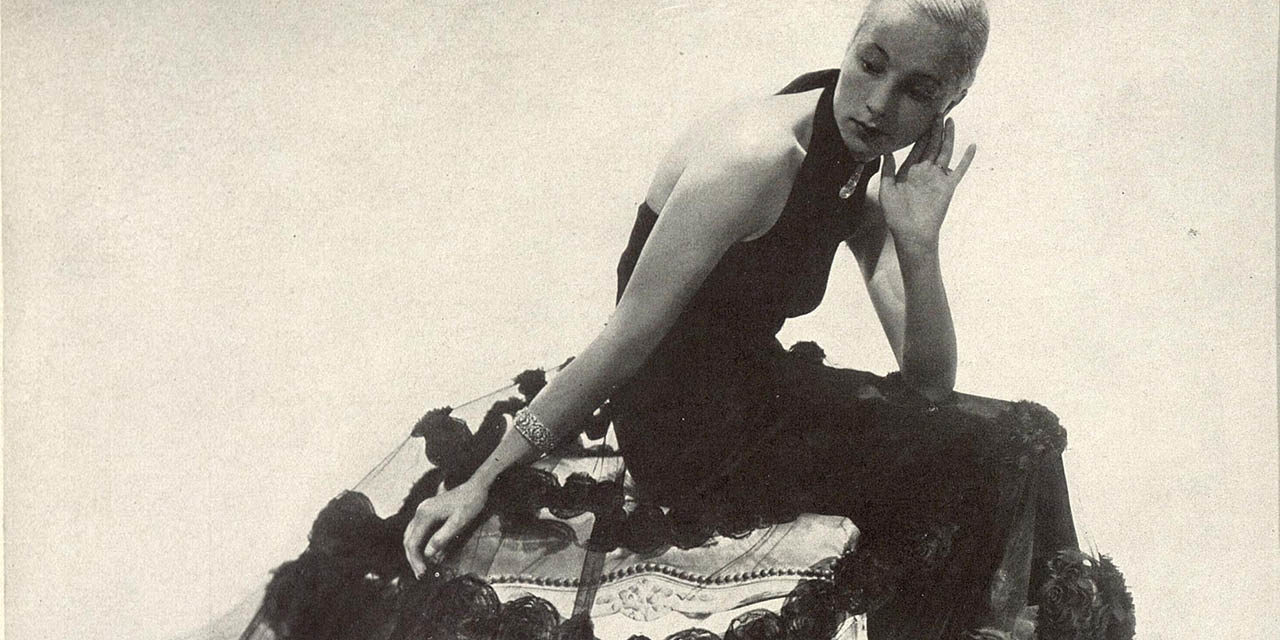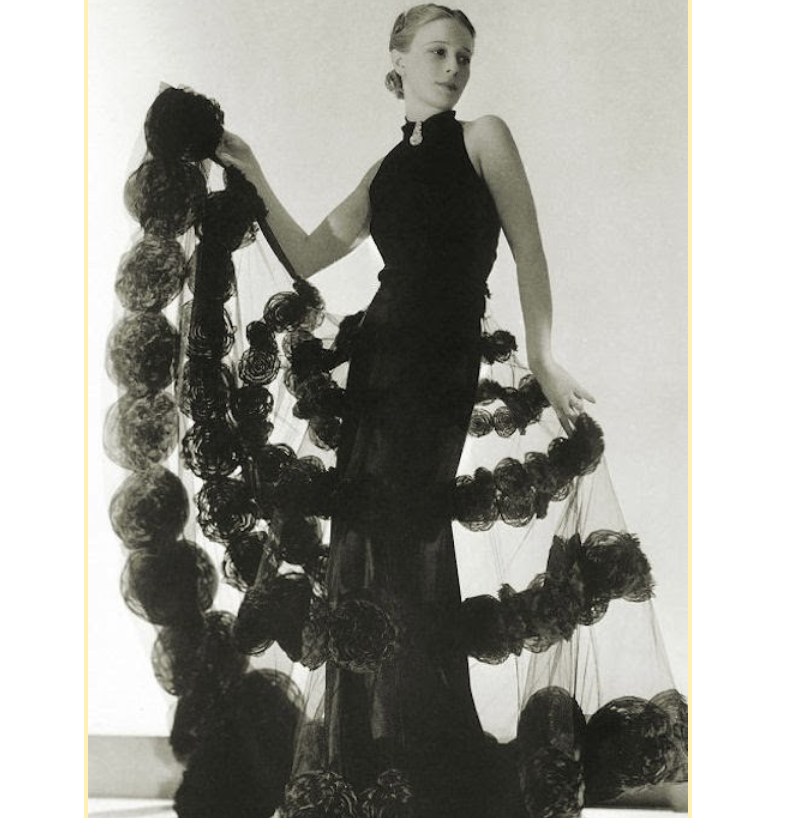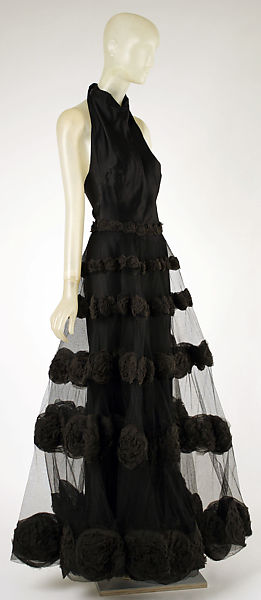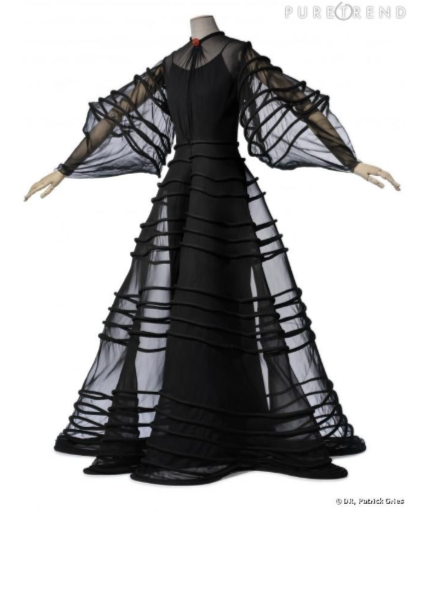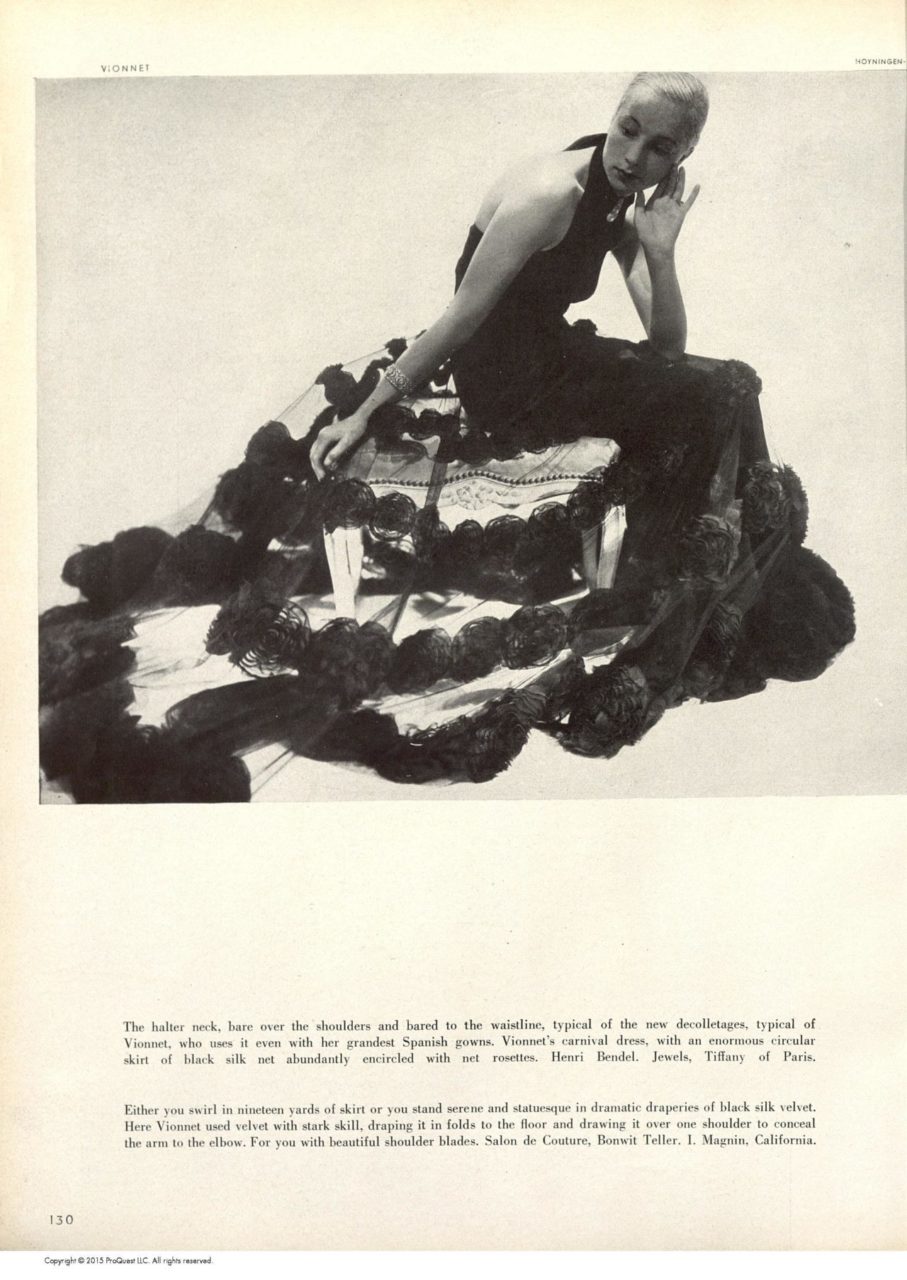Vionnet’s exquisite technique and ingenious construction–like that seen in her 1936 carnival dress–popularized her designs internationally throughout the 1920s and 1930s.
About the Look
Madeleine Vionnet modernized fashion through her impeccable craftsmanship and advanced designs creating fashions that were functional, yet chic. The dressmaker is credited with the invention of the bias cut, a technique designed to highlight the body’s fluidity creating luscious movement through plush draping that hangs delicately on the figure’s frame. With a blend of Grecian influence, Art Deco inspiration, and Victorian flare, the House of Vionnet presented the “Carnival Dress”, in 1936.
The carnival dress is composed in two parts, the bias cut silk halter dress (Fig. 1) and the detachable tulle skirt. In removing the tulle skirt from the ensemble, the bias cut can be clearly identified through the garments body morphing silhouette, and organic pleating. Cut on the bias, the carnival dress creates unrestricted movement while molding itself to the natural shape of the body.
The carnival dress is cinched at the waist by a sheer tulle skirt embellished with pin-tucked rosettes (Fig. 2). The repetitive nature of the garment’s embellishments was inspired by the 1920s Art Deco movement. A contemporary photograph with the model holding up the skirt highlights the diaphanous effect of the tiers of rosettes against the sleek black sheath (Fig. 3).
Fig. 1 - Madeleine Vionnet (French, 1876-1975). Carnival dress, 1936. Silk. New York: The Metropolitan Museum of Art, C.I.52.24.3a, b. Gift of Mrs. Harrison Williams, 1952. Source: The Met
Fig. 2 - Madeleine Vionnet (French, 1876-1965). Carnival dress, 1936. Silk. New York: Metropolitan Museum of Art, C.I.52.24.3a, b. Gift of Mrs. Harrison Williams, 1952. Source: The Met
Fig. 3 - Photographer unknown. Carnival dress, 1936. Source: Gods and Foolish Grandeur
Madeleine Vionnet (French, 1876–1975), Carnival Dress, 1936. Silk. New York City: The Metropolitan Museum of Art, C.I.52.24.3a, b. Gift of Mrs. Harrison Williams, 1952. Source: The Met
About the context
French couturier Madeleine Vionnet, known as an “architect among dressmakers,” pioneered an unconventional approach to design that has withstood the test of time. Morphing bits of fabric into brilliant evening gowns, the dressmaker trademarked the utilization of geometric shapes, specifically squares and rectangles, in bringing her designs to life. The bias cut’s construction and function is discussed by fashion historian Betty Kirke in Madeleine Vionnet (1998):
“This dress is composed of squares cut on the grain but hung on the bias, with shaping at the shoulder and hem for a better fit and function. To prevent stretching, the squares were hand sewn together to form the tube that covered the body.” (54)
Vionnet was inspired by Grecian statues that epitomize fabric manipulation. The dressmaker often turned to artifacts like the Winged Victory of Samothrace (Fig. 4) as inspiration throughout her collections to guide her creative execution. Ciara Phipps writes in “1930s Influence on the Catwalk 1975-2000” (2015):
“Vionnet’s design ethos rejected everything that distorted the natural curves of the body and understood that fabric cut on the bias could be sumptuously draped into the folds, mirroring the fluidity of the body itself.”
The repeated pin-tucked rosette design found on the tulle overskirt stays true to Vionnet’s style as fashion historians Daniel James Cole and Nancy Deihl note in The History of Modern Fashion (2015): “Vionnet frequently used repeated shapes, a design element typical of art deco” (146).
In addition to Art Deco inspiration, the carnival dress also reflects a mid-19th century silhouette. The Metropolitan Museum of Art describes the historical context of Vionnet’s voluminous crinoline inspired skirt, writing:
“the skirt of this ensemble references crinolines of the 1850s and 1860s. Traditionally made out of wired hoops connected by canvas tapes, crinolines were worn under a skirt to give it a fashionable bell-shaped volume.”
Vionnet’s honeycomb dress (Fig. 5), believed to be from the same 1936 collection, exemplifies the designer’s manipulation of fabric, creating outstanding volume and shape while modernizing Victorian fashions by replacing wire and boning with sheer volume.
Vionnet’s innovative techniques executed through her ingenious construction of evening and outerwear quickly popularized her designs internationally throughout the 1920s-30s. In the October issue of Harper’s Bazaar (1936), an image of Vionnet’s carnival dress was featured (Fig. 6) along with a caption that reads:
“The halter neck, bare over the shoulders and bared to the waistline, typical of the new decolletages, typical of Vionnet, who uses it even with her grandest Spanish gowns. Vionnet’s carnival dress, an enormous circular skirt of black silk net, abundantly encircled with net rosettes.” (130)
Madeleine Vionnet is regarded as one of the most influential designers of modern fashion. Her cubist-inspired creativity operated in an obscure manner that the fashion industry had never seen before. Her ability to accentuate the body’s natural curves propelled her to stardom.
Fig. 4 - Artist unknown (Greek). The Winged Victory of Samothrace, 2nd century BCE. Parian marble; 244 cm (96 in). Paris, France: Louvre Museum, 7A3-G-LM-WVS-A1. Source: Louvre Museum
Fig. 5 - Madeleine Vionnet (French, 1876-1975). Honeycomb dress, 1936. Silk, tulle. Paris, France: Les Arts Décoratifs. Gift of Madeleine Vionnet, 1952. Source: Les Arts Décoratifs
Fig. 6 - George Hoyningen-Huene (Russian, 1900-1968). "Black Tulle, Black Velvet," Harper's Bazaar, vol. 69, no. 2688 (October 1936): 130. Source: ProQuest
References:
- “Black Tulle, Black Velvet.” Harper’s Bazaar, 10, 1936, 130-131, https://libproxy.fitsuny.edu:2818/docview/1860678815?accountid=27253.
- Cole, Daniel James, and Nancy Deihl. The History of Modern Fashion from 1850. London: Laurence King Publishing, 2015. http://www.worldcat.org/oclc/932219920.
- Kirke, Betty. Madeleine Vionnet. San Francisco: Chronicle Books, 1998. http://www.worldcat.org/oclc/815613924.
- “Madeleine Vionnet | ‘Carnival Dress’ | French | The Met.” The Metropolitan Museum of Art, i.e. The Met Museum. Accessed February 27, 2019. https://www.metmuseum.org/art/collection/search/84702.
- Phipps, Ciara. “1930s Influences on the Catwalk, 1975–2000.” In Fashion Photography Archive. London: Bloomsbury, 2015. Accessed April 14, 2019. http://dx.doi.org/10.5040/9781474260428-FPA410.

